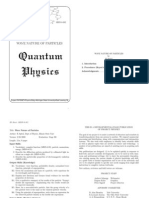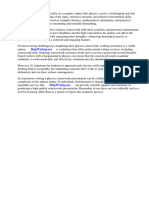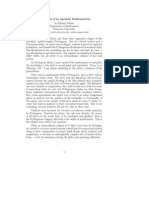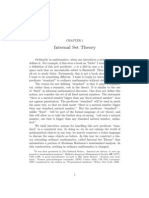Conserved Quantities: An Overview: Project PHYSNET Physics Bldg. Michigan State University East Lansing, MI
Conserved Quantities: An Overview: Project PHYSNET Physics Bldg. Michigan State University East Lansing, MI
Uploaded by
Epic WinCopyright:
Available Formats
Conserved Quantities: An Overview: Project PHYSNET Physics Bldg. Michigan State University East Lansing, MI
Conserved Quantities: An Overview: Project PHYSNET Physics Bldg. Michigan State University East Lansing, MI
Uploaded by
Epic WinOriginal Description:
Original Title
Copyright
Available Formats
Share this document
Did you find this document useful?
Is this content inappropriate?
Copyright:
Available Formats
Conserved Quantities: An Overview: Project PHYSNET Physics Bldg. Michigan State University East Lansing, MI
Conserved Quantities: An Overview: Project PHYSNET Physics Bldg. Michigan State University East Lansing, MI
Uploaded by
Epic WinCopyright:
Available Formats
MISN-0-275
CONSERVED QUANTITIES: AN OVERVIEW
s d u
CONSERVED QUANTITIES: AN OVERVIEW by J. Christman, U. Coast Guard Academy
L0
ene
- s
d d
u d
1. Introduction a. Overview . . . . . . . . . . . . . . . . . . . . . . . . . . . . . . . . . . . . . . . . . . . . . . . . 1 b. Denition of Conserved Quantity. . . . . . . . . . . . . . . . . . . . . 1 c. Quantities Conserved Depend on Interaction . . . . . . . . . . . . . 1 d. Correlation With Interaction Strength . . . . . . . . . . . . . . . . . . . 1 2. Assigned Reading . . . . . . . . . . . . . . . . . . . . . . . . . . . . . . . . . . . . . . . . 2
L S
p
ene
pn
3. Universally Conserved Quantities a. List of Properties . . . . . . . . . . . . . . . . . . . . . . . . . . . . . . . . . . . . . . . . 2 b. Intrinsic vs. Dynamic Properties . . . . . . . . . . . . . . . . . . . . . . . . 2 c. CPT . . . . . . . . . . . . . . . . . . . . . . . . . . . . . . . . . . . . . . . . . . . . . . . . . . . . 3 4. Properties Conserved by Each Interaction a. Weak Force: Only Universal Quantities . . . . . . . . . . . . . . . . . . 3 b. EM and Strong Forces: Additional Constraints . . . . . . . . . . 3 c. Time Reversal Indicates Two Weak Forces . . . . . . . . . . . . . . . 3 Acknowledgments. . . . . . . . . . . . . . . . . . . . . . . . . . . . . . . . . . . . . . . . . . . .3
Project PHYSNET Physics Bldg. Michigan State University East Lansing, MI
ID Sheet: MISN-0-275 THIS IS A DEVELOPMENTAL-STAGE PUBLICATION OF PROJECT PHYSNET The goal of our project is to assist a network of educators and scientists in transferring physics from one person to another. We support manuscript processing and distribution, along with communication and information systems. We also work with employers to identify basic scientic skills as well as physics topics that are needed in science and technology. A number of our publications are aimed at assisting users in acquiring such skills. Our publications are designed: (i) to be updated quickly in response to eld tests and new scientic developments; (ii) to be used in both classroom and professional settings; (iii) to show the prerequisite dependencies existing among the various chunks of physics knowledge and skill, as a guide both to mental organization and to use of the materials; and (iv) to be adapted quickly to specic user needs ranging from single-skill instruction to complete custom textbooks. New authors, reviewers and eld testers are welcome. PROJECT STAFF Andrew Schnepp Eugene Kales Peter Signell Webmaster Graphics Project Director
Title: Conserved Quantities: An Overview Author: J.R. Christman, Dept. of Physical Science, U. S. Coast Guard Acad., New London, CT Version: 2/1/2000 Length: 2 hr; 8 pages Input Skills: 1. Vocabulary: conservation law (MISN-0-15). 2. State the family and family group to which a given strong-stable particle belongs (MISN-0-274). Output Skills (Knowledge): K1. Explain what is meant when an elementary-particle quantity is said to be conserved and when it is said to be universally conserved. K2. List the names of all the quantities which may be conserved in elementary particle interactions. K3. For each type of elementary particle interaction, list the conserved quantities. External Resources (Required): 1. K. W. Ford, Classical and Modern Physics, Vol. 1, John Wiley and Sons (1972). Post-Options: 1. Universally Conserved Quantities in Elementary Particle Interactions (MISN-0-276). 2. Additional Properties Conserved in Electromagnetic and Strong Interactons (MISN-0-277). Evaluation: Stage B1
ADVISORY COMMITTEE D. Alan Bromley E. Leonard Jossem A. A. Strassenburg Yale University The Ohio State University S. U. N. Y., Stony Brook
Views expressed in a module are those of the module author(s) and are not necessarily those of other project participants. c 2001, Peter Signell for Project PHYSNET, Physics-Astronomy Bldg., Mich. State Univ., E. Lansing, MI 48824; (517) 355-3784. For our liberal use policies see: http://www.physnet.org/home/modules/license.html.
MISN-0-275
MISN-0-275
CONSERVED QUANTITIES: AN OVERVIEW by J. Christman, U. Coast Guard Academy 1. Introduction
1a. Overview. Certain particle properties are conserved in interactions and decays. The purpose of this unit is to enumerate such properties and to discuss conservation laws in a general way. Details of the properties are discussed elsewhere.1 1b. Denition of Conserved Quantity. . Here is the meaning of conserved property in a particle interaction or decay: A number representing the property can be assigned to each particle entering the interaction and to each particle produced by the interaction. There exists a scheme for calculating the total amount of the property both for particles entering and for particles leaving the interaction. If the entering total and leaving total are the same, the property is said to be conserved. 1c. Quantities Conserved Depend on Interaction. The list of properties which are conserved is characteristic of the type of interaction. Those properties which are conserved in all 4 types of interaction are called universally conserved quantities. In addition, there is a property which is conserved in strong interactions but not in the others, and there are properties which are conserved in electromagnetic interactions but not in weak ones. 1d. Correlation With Interaction Strength. It is interesting, but perhaps coincidental, that if a property is conserved by one type of interaction it is conserved by all stronger interactions. That is, the list of conserved properties for the electromagnetic interaction contains all those on the list for the weak interaction plus four others and the list for the strong interaction includes all those for the electromagnetic in1 Universally Conserved Quantities in Elementary Particle Interactions (MISN-0276). Also see Reference 3.
teraction plus one other. Little experimental information exists for the gravitational interaction.
2. Assigned Reading
Sections 4.1 through 4.7 in K.W. Fords Classical and Modern Physics, Vol. 1, John Wiley and Sons, NYC (1972), on reserve for you in the PA Library: Ask for the readings for Unit 275.
3. Universally Conserved Quantities
3a. List of Properties. These quantities are universally conserved in elementary particle interactions:2 a. energy b. linear momentum c. angular momentum d. electric charge e. baryon number f. electron-muon-tauon number. g. lepton number In special relativity, energy becomes the fourth component of the (now four-dimensional) momentum vector. Conservation of this fourmomentum implies conservation of both energy and momentum. 3b. Intrinsic vs. Dynamic Properties. The last four properties in Sect. 3a, items d-g, are intrinsic properties of the particle. The rst three, items a-c, depend on the dynamical situation. For example, electrons may have dierent momenta, depending on the extent to which they have been accelerated, but all electrons have the same charge, baryon number, electron number, muon number, tauon number, and lepton number.
2 Older references may have lists of conserved quantities that are obsolete and hence dier from the up-to-date list given here.
MISN-0-275
MISN-0-275
3c. CPT. There is another quantity, called CPT, which is believed to be universally conserved. This quantity is the product of the quantities for charge conjugation invariance (C), parity invariance (P), and time reversal invariance (T). The meaning of C, P, and T are discussed elsewhere.3
tion of this module was supported in part by the National Science Foundation, Division of Science Education Development and Research, through Grant #SED 74-20088 to Michigan State University.
4. Properties Conserved by Each Interaction
4a. Weak Force: Only Universal Quantities. All of the universal quantities listed in Sect. 3a are conserved by the weak interaction. With the exceptions noted in Sections 3c and 4c, no other known quantities are conserved by the weak interaction. 4b. EM and Strong Forces: Additional Constraints. In addition to the seven universal properties, these properties are also conserved by the electromagnetic interaction: h. parity i. strangeness j. charge conjugation k. time reversal In addition to the above listed properties, the strong interaction also conserves a quantity called isospin. 4c. Time Reversal Indicates Two Weak Forces. Eects which stem from the violation of time reversal invariance by the weak interaction are roughly one-thousandth as strong as the more usual eects of the weak interaction. This has led some physicists to believe that the force which has been traditionally called the weak interaction is, in reality, two forces, the stronger of which is time reversal invariant and the weaker of which is not. This super weak force, if it exists, is a fth force of nature. Here we do not make a distinction between these two weak forces.
Acknowledgments
Preparation of this module was supported in part by the United States Coast Guard Academy for a Directed Studies Program. Prepara3 Additional Properties Conserved in Electromagnetic and Strong Interactions (MISN-0-277).
You might also like
- Jaffe R., Taylor W. The Physics of Energy 2018Document895 pagesJaffe R., Taylor W. The Physics of Energy 2018sudiana i nyoman100% (2)
- Applied Bioelectricity - RizadianDocument580 pagesApplied Bioelectricity - RizadianFarrel Alfayyed100% (1)
- Particles and Interactions: Project PHYSNET Physics Bldg. Michigan State University East Lansing, MIDocument6 pagesParticles and Interactions: Project PHYSNET Physics Bldg. Michigan State University East Lansing, MIEpic WinNo ratings yet
- The Strong Interaction: Project PHYSNET Physics Bldg. Michigan State University East Lansing, MIDocument6 pagesThe Strong Interaction: Project PHYSNET Physics Bldg. Michigan State University East Lansing, MIEpic WinNo ratings yet
- M 255Document8 pagesM 255Epic WinNo ratings yet
- The Weak Interaction: Project PHYSNET Physics Bldg. Michigan State University East Lansing, MIDocument8 pagesThe Weak Interaction: Project PHYSNET Physics Bldg. Michigan State University East Lansing, MIEpic WinNo ratings yet
- Conductivity and Resistance: Charge CarrierDocument10 pagesConductivity and Resistance: Charge CarrierEpic WinNo ratings yet
- Intermolecular Forces Lesson PlanDocument13 pagesIntermolecular Forces Lesson Plancheryl tayasNo ratings yet
- Energy and Momentum in Electromagnetic WavesDocument6 pagesEnergy and Momentum in Electromagnetic WavesEpic WinNo ratings yet
- Wave-Particle Duality: Light: Project PHYSNET Physics Bldg. Michigan State University East Lansing, MIDocument10 pagesWave-Particle Duality: Light: Project PHYSNET Physics Bldg. Michigan State University East Lansing, MIEpic WinNo ratings yet
- Wave Nature of Particles: MISN-0-382Document5 pagesWave Nature of Particles: MISN-0-382Epic WinNo ratings yet
- Physics XIDocument24 pagesPhysics XIPavithra PrakashNo ratings yet
- Main 170713055801Document151 pagesMain 170713055801Zain RahimNo ratings yet
- Current Work in Elementary Particles: Project PHYSNET Physics Bldg. Michigan State University East Lansing, MIDocument11 pagesCurrent Work in Elementary Particles: Project PHYSNET Physics Bldg. Michigan State University East Lansing, MIEpic WinNo ratings yet
- Physical Science: Quarter 2 - Module 13 Special Theory of RelativityDocument21 pagesPhysical Science: Quarter 2 - Module 13 Special Theory of RelativityLlahona FajardoNo ratings yet
- CH - 1 Physical WorldDocument25 pagesCH - 1 Physical Worldsatpal chahalNo ratings yet
- (Synthesis Lectures On Engineering) Richard F. Tinder - Tensor Properties of Solids-Morgan and Claypool Publishers (2008)Document158 pages(Synthesis Lectures On Engineering) Richard F. Tinder - Tensor Properties of Solids-Morgan and Claypool Publishers (2008)Marco FernandezNo ratings yet
- Physics Coursework PresentationDocument5 pagesPhysics Coursework Presentationg1hulikewes2100% (2)
- Applications of Maxwell EquationsDocument432 pagesApplications of Maxwell EquationssplouvrosNo ratings yet
- Iasbaba Daily Prelims Test (Day 5) : Science & Technology and Current AffairsDocument11 pagesIasbaba Daily Prelims Test (Day 5) : Science & Technology and Current AffairssuryakumarNo ratings yet
- Physical World Paper 1Document5 pagesPhysical World Paper 1intelligentc47No ratings yet
- Uts Efp Vivi RJDocument5 pagesUts Efp Vivi RJVivi Pipi RJNo ratings yet
- Relativistic Energy Reaction Thresholds, Binding EnergiesDocument8 pagesRelativistic Energy Reaction Thresholds, Binding EnergiesEpic WinNo ratings yet
- Exponential Decay: Project PHYSNET Physics Bldg. Michigan State University East Lansing, MIDocument8 pagesExponential Decay: Project PHYSNET Physics Bldg. Michigan State University East Lansing, MIEpic WinNo ratings yet
- Fundamentals of Radiation Materials Science - Metals and Alloys (PDFDrive)Document1,014 pagesFundamentals of Radiation Materials Science - Metals and Alloys (PDFDrive)Bujji Raju100% (1)
- Set1 Notes EE2103 IntroDocument12 pagesSet1 Notes EE2103 Introharshagarwal2813No ratings yet
- Dissertation VCDocument62 pagesDissertation VCJames SteeleNo ratings yet
- Nat Sci ReviewerDocument10 pagesNat Sci ReviewerZen-Zen Baes100% (2)
- ThermodynamicsDocument15 pagesThermodynamicsSmitha KollerahithluNo ratings yet
- Aspirants AS1143 11th Physics 235 Marks Study Materials English Medium PDFDocument29 pagesAspirants AS1143 11th Physics 235 Marks Study Materials English Medium PDFmagishtimes siva100% (1)
- Physical WorldDocument3 pagesPhysical WorldSreekanth KilimanoorNo ratings yet
- Phys Question BankDocument23 pagesPhys Question BankSai SriramNo ratings yet
- (2nd Month) STM 128 - General Chemistry 2Document36 pages(2nd Month) STM 128 - General Chemistry 2ibnolyn2003No ratings yet
- CRITICAL Journal Review ChemistryDocument26 pagesCRITICAL Journal Review ChemistryNIA AUDINA SITANGGANGNo ratings yet
- Physics Questions Sem..Document14 pagesPhysics Questions Sem..VinitgaNo ratings yet
- Harmonic Perturbations: Project PHYSNET Physics Bldg. Michigan State University East Lansing, MIDocument4 pagesHarmonic Perturbations: Project PHYSNET Physics Bldg. Michigan State University East Lansing, MIEpic WinNo ratings yet
- 1.1 Understanding Physics: Attempt The Following Questions On Your Own What Is Physics?Document8 pages1.1 Understanding Physics: Attempt The Following Questions On Your Own What Is Physics?Ushma PunatarNo ratings yet
- Lecture Notes - Solid State PhysicsDocument80 pagesLecture Notes - Solid State Physicspaul kamweruNo ratings yet
- Intermolecular Forces Lesson PlanDocument34 pagesIntermolecular Forces Lesson Planapi-442754652No ratings yet
- Physics For Bioscience: Rajalakshmi Engineering College (Autonomous) Thandalam, Chennai - 602105Document193 pagesPhysics For Bioscience: Rajalakshmi Engineering College (Autonomous) Thandalam, Chennai - 602105Thaya GanapathyNo ratings yet
- Iit - Foundation - Set - IVDocument287 pagesIit - Foundation - Set - IVHargovind NainaniNo ratings yet
- Numerical Demonstration of Energy Quantization For Atomic HydrogenDocument10 pagesNumerical Demonstration of Energy Quantization For Atomic HydrogenEpic WinNo ratings yet
- Electricity and Magnetism: Electromagnetic WavesDocument4 pagesElectricity and Magnetism: Electromagnetic WavesEpic WinNo ratings yet
- Ucd: Physics 9C - Electricity and Magnetism: Tom WeidemanDocument173 pagesUcd: Physics 9C - Electricity and Magnetism: Tom WeidemanEuler Portilla CarrascoNo ratings yet
- Physicalscience q2 Mod14 TheconsequencesofthepostulatesofspecialrelativitytheoryDocument27 pagesPhysicalscience q2 Mod14 TheconsequencesofthepostulatesofspecialrelativitytheoryHanzel MabilanganNo ratings yet
- Mass and Weight: Project PHYSNET Physics Bldg. Michigan State University East Lansing, MIDocument10 pagesMass and Weight: Project PHYSNET Physics Bldg. Michigan State University East Lansing, MIEpic WinNo ratings yet
- Self-Inductance and Inductors: Project PHYSNET Physics Bldg. Michigan State University East Lansing, MIDocument6 pagesSelf-Inductance and Inductors: Project PHYSNET Physics Bldg. Michigan State University East Lansing, MIEpic WinNo ratings yet
- Electricity and Magnetism: Dielectrics Displacement VectorDocument4 pagesElectricity and Magnetism: Dielectrics Displacement VectorEpic WinNo ratings yet
- Module 1 - Introduction To Mechanics PDFDocument10 pagesModule 1 - Introduction To Mechanics PDFsubyNo ratings yet
- Introduction To Physics (Teacher)Document22 pagesIntroduction To Physics (Teacher)MNYNo ratings yet
- Test Bank For Mosbys Respiratory Care Equipment 10th Edition by CairoDocument44 pagesTest Bank For Mosbys Respiratory Care Equipment 10th Edition by CairozujeyhoduckNo ratings yet
- Chemistry UBDFINAL2017Document20 pagesChemistry UBDFINAL2017general1.secondaryNo ratings yet
- Particles PhysicsDocument362 pagesParticles PhysicssemNo ratings yet
- 1st Quarter Course Outline in Science 8 SY2016-2017Document5 pages1st Quarter Course Outline in Science 8 SY2016-2017James B Malicay50% (2)
- TGR MMM Notes PDFDocument37 pagesTGR MMM Notes PDFsch203No ratings yet
- Modeling The Mechanical Behaviour of Heterogeneous Multi-Phase MaterialsDocument27 pagesModeling The Mechanical Behaviour of Heterogeneous Multi-Phase MaterialsChris RodopoulosNo ratings yet
- Stat & Prob 1 LPDocument22 pagesStat & Prob 1 LPWilber TuryasiimaNo ratings yet
- Chapter 5 Chemistry of Engineering MaterialsDocument36 pagesChapter 5 Chemistry of Engineering Materialsksm rachasNo ratings yet
- Elementary Particle Physics in a NutshellFrom EverandElementary Particle Physics in a NutshellRating: 4.5 out of 5 stars4.5/5 (3)
- Syntax and Semantics: WWW - Math.princeton - Edu Nelson Papers - HTMLDocument7 pagesSyntax and Semantics: WWW - Math.princeton - Edu Nelson Papers - HTMLEpic WinNo ratings yet
- Warning Signs of A Possible Collapse of Contemporary MathematicsDocument12 pagesWarning Signs of A Possible Collapse of Contemporary MathematicsEpic WinNo ratings yet
- Mathematics and The Mind: Nelson/papers - HTMLDocument6 pagesMathematics and The Mind: Nelson/papers - HTMLEpic WinNo ratings yet
- InequalitiesDocument192 pagesInequalitiesEpic Win100% (2)
- The Mystery of Stochastic MechanicsDocument18 pagesThe Mystery of Stochastic MechanicsEpic WinNo ratings yet
- IstDocument34 pagesIstEpic WinNo ratings yet
- Nelson BibDocument5 pagesNelson BibEpic WinNo ratings yet
- RomeDocument7 pagesRomeEpic WinNo ratings yet
- Hilbert's Mistake: Edward Nelson Department of Mathematics Princeton UniversityDocument27 pagesHilbert's Mistake: Edward Nelson Department of Mathematics Princeton UniversityEpic WinNo ratings yet
- Understanding Intuitionism: WWW - Math.princeton - Edu Nelson Papers - HTMLDocument20 pagesUnderstanding Intuitionism: WWW - Math.princeton - Edu Nelson Papers - HTMLEpic WinNo ratings yet
- J-Spectra For A Quotient Group J of G. That Context Gives An Interesting SituationDocument9 pagesJ-Spectra For A Quotient Group J of G. That Context Gives An Interesting SituationEpic WinNo ratings yet
- HopeDocument4 pagesHopeEpic WinNo ratings yet
- J. P. MayDocument17 pagesJ. P. MayEpic WinNo ratings yet
- Edward NelsonDocument1 pageEdward NelsonEpic WinNo ratings yet
- Internal Set TheoryDocument26 pagesInternal Set TheoryEpic WinNo ratings yet
- Probability Theory: 1 Heuristic IntroductionDocument17 pagesProbability Theory: 1 Heuristic IntroductionEpic WinNo ratings yet
- Radical Stability-Thermochemical Aspects: Johnny Hioe and Hendrik ZipseDocument27 pagesRadical Stability-Thermochemical Aspects: Johnny Hioe and Hendrik ZipseNaman GuptaNo ratings yet
- M MMMMMMMMMMDocument3 pagesM MMMMMMMMMMDavid R PaucaraNo ratings yet
- Single-Phase Induction Motor - Double Field Revolving Theory - Electrical Machines IIIDocument4 pagesSingle-Phase Induction Motor - Double Field Revolving Theory - Electrical Machines IIIpradhapdNo ratings yet
- Wave PropagationDocument40 pagesWave PropagationMerlyCalvaNo ratings yet
- F4Physics Test2 (2016)Document10 pagesF4Physics Test2 (2016)TS Shong100% (1)
- Chapter 8 QuestionsDocument3 pagesChapter 8 QuestionsGaurav SrivastavaNo ratings yet
- Antenna and PropagationDocument9 pagesAntenna and PropagationMNorace GosaiNo ratings yet
- Mechanism of Calcium Carbonate Scale Deposition UnderDocument7 pagesMechanism of Calcium Carbonate Scale Deposition UnderDiman Aditya KardiNo ratings yet
- Sloshing in A Vertical Circular Cylindrical Tank With An Annular Baf E. Part 1. Linear Fundamental SolutionsDocument18 pagesSloshing in A Vertical Circular Cylindrical Tank With An Annular Baf E. Part 1. Linear Fundamental Solutions조기현No ratings yet
- Unit 5 Ensembles in Quantum Statistical PhysicsDocument18 pagesUnit 5 Ensembles in Quantum Statistical PhysicsOmar OuljiNo ratings yet
- LECTURE FOUR-Xray Photoelectron Up SpecDocument13 pagesLECTURE FOUR-Xray Photoelectron Up Specbenjamin bosireNo ratings yet
- Unit2Document24 pagesUnit2Manav HnNo ratings yet
- Grade 7-Week 3&4 Concept EvaluationDocument3 pagesGrade 7-Week 3&4 Concept EvaluationCozette AtendidoNo ratings yet
- Computers and Chemical Engineering: William L. LuybenDocument6 pagesComputers and Chemical Engineering: William L. LuybendanaosajoNo ratings yet
- Micromechanical Assessment of An Internal Stability CriterionDocument10 pagesMicromechanical Assessment of An Internal Stability CriterionGovind1085No ratings yet
- 7671 4j4a TableDocument1 page7671 4j4a TableiqkhanukNo ratings yet
- 2019 A Level H2 Chemistry P3 Ans SharingDocument21 pages2019 A Level H2 Chemistry P3 Ans Sharingclarissa yeoNo ratings yet
- Crane UbDocument20 pagesCrane UbBobor Emmanuel OfovweNo ratings yet
- Effect of Sodium Lauryl Sulfate in Dissolution Media On Dissolution of Hard Gelatin Capsule ShellsDocument5 pagesEffect of Sodium Lauryl Sulfate in Dissolution Media On Dissolution of Hard Gelatin Capsule ShellssamxuNo ratings yet
- Grade 8 Quarter 3 - DLLDocument39 pagesGrade 8 Quarter 3 - DLLDhangManongas-LlaboreVete100% (2)
- Physics Lab Report.Document23 pagesPhysics Lab Report.Muhammad Sohag HussainNo ratings yet
- Experiment 402 - Plane and Spherical MirrorsDocument9 pagesExperiment 402 - Plane and Spherical MirrorsゆかりNo ratings yet
- PT316 - Topic 1 - Single Particles in Fluids PDFDocument30 pagesPT316 - Topic 1 - Single Particles in Fluids PDFChemEngGirl89No ratings yet
- Introduction To Fourier Optics 2nd - J. GoodmanDocument5 pagesIntroduction To Fourier Optics 2nd - J. GoodmanOsbaldo ReyesNo ratings yet
- Instructional Planning: Unit Plan: Neutral Atom/Atomic Structure 8 Grade Janet AneniDocument4 pagesInstructional Planning: Unit Plan: Neutral Atom/Atomic Structure 8 Grade Janet Aneniapi-377802356No ratings yet
- Equations of Motion: ME 231: DynamicsDocument16 pagesEquations of Motion: ME 231: Dynamicsarunscribd20No ratings yet
- Most of The Answers Have Been Rounded Up or Rounded Down To Three Significant Figures (3Sf) Question 1: (A) Mno + 8H + 5fe MN + 5fe + 4H ODocument10 pagesMost of The Answers Have Been Rounded Up or Rounded Down To Three Significant Figures (3Sf) Question 1: (A) Mno + 8H + 5fe MN + 5fe + 4H Ohany mohamedNo ratings yet
- Csir-Ugc-Net/Jrf - Gate - Physics: V X That Satisfies The Condition (V X VXDocument4 pagesCsir-Ugc-Net/Jrf - Gate - Physics: V X That Satisfies The Condition (V X VXAbhrajit MahapatraNo ratings yet
- Exercise - 1 Iit/Jee: (Single Correct Choice Type Questions)Document28 pagesExercise - 1 Iit/Jee: (Single Correct Choice Type Questions)Paliwal DineshNo ratings yet
- List of Selected Constant Values: DP024 Set 1Document7 pagesList of Selected Constant Values: DP024 Set 1mohamad hafizNo ratings yet









































































































